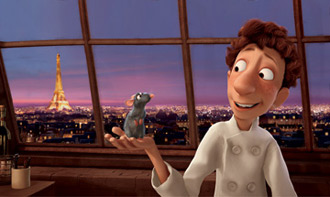Disney animated films attach different accents to different characters. It remains a wonder then whether the use of various accents represents different levels of characters in these films. The question remains as to whether there is a systematic way within which accents are used to come up with different character traits?
Given that Disney animated films is an American company, the most common accent that is likely to be used is GA or General American. This accent is likely to be attributed to good characters, on the other hand English with a foreign accent and/ or RP i.e.
Received Pronunciation represents the accents that are likely to be attributed to less favorable characters. Other than looking at how accent has been used in Ratatouille to portray different stereotypical kinds of characters, this article will also look at how this compares with Rosina Lippi-Green’s work, “Teaching Children How to Discriminate”.
The assumption that social pressures to conform with stipulated modes of behavior, lifestyle and prevailing culture has had its fare share of determining how Disney use accents in its animated films cannot be far from the truth. The issue of ethnicity is reflected by allocating an accent to a character inline with his or her perceived ethnic background.
The setting of the movie also determines the accent to be allocated to characters. If the setting is in a place where use of GA is unlikely, then RP is used instead. Use of accents in animated films can help reveal societal norms by showing what accents are preferred to others.
Through the use of accents as an artistic device, the movie audience can easily infer the various characters background, intelligence, social status, race or ethnicity among other traits. Thus, accents in movies reveal stereotypes attached to different people at any given one time.
The use of accents in animated movies can be used as a way of promoting standard language ideology to children. This is easily achieved when there is a direct correlation between the character and the accent. Since animated movies are intended for children, stereotypical features are clearly defined and there is certainly no need of second guessing.
Ratatouille is an animated film for children despite the fact that it has so many story strands that are related to adults. The characters in the movie use strong French accent that is quite difficult for children to figure out what is being said.
The title of the movie is derived from a French soup not to mention that it is ironical in how it sounds as the co starring in the movie is a rat named Remy who forges an alliance with Linguini the talentless chef who is about to be fired. Linguini tells Remy”Let’s think this out, you know how to cook, and I know how to…. appear human…” Remy is guided by an apparition of Auguste Gusteau that helps him to intervene through Linguini when a soup that has been tampered with is about to be served in Gusteaus’s restaurant.
Through Remy’s genius, the savor of the soup is improved and it attracts accolade that saves Linguini’s job who gets promoted instead of being fired.
Ratatouille is set in Paris, France and the dominant accent is French which suits the setting, however, the protagonist speaks GA, for instance when asking Remy a question “.Uh, whatto I do after the onions?” Therefore, a question arises as to whether the use of language is biased towards spreading a standard language ideology towards children.
The question can be best answered by noting how all chefs are denoted to speak French-accented English. Lippi-Green noted that in all French films, the prototypical French who are truly French are the characters concerned with food preparation.
This means that the setting of the movie is not the issue in allocation of French-accented English; rather, this accent is used stereotypically to represent characters that are truly French. The hero is depicted as a male and his aide a lady, chef Collette who speaks French-accented English.
She is depicted as being kind and less sophisticated i.e. when she says “What is this? Keep….your… station clear! , I’ll make this easy to remember, Keep your station clear…. or I will kill you!” Anton Ego the villain who criticizes food made by Linguini speaks French-accented English and his looks are those of an evil person.
In this film, the three rats namely Remy, his brother and father and Linguini speaks GA while most of the characters speak English with French accent.
The movie setting naturally makes as presume that the characters should all speak French accented English even if they are animals, also, Linguini a human should not speak GA as he is in France and his name which means pasta does not indicate that he is an American in any way in any case he is all French just like the rest of the characters.
This bias shows that accent has been used as an artistic device to make Linguini stand out as the ideal hero. By selecting GA as the ideal accent for the protagonist, all that Disney is doing is try and conform to the expectations of the audience.
This indicates people’s attitudes towards some accents. If the hero should speak some other accent other than the GA, the audience could deem that to be improper and they could easily react negatively since such a trend is simply not right.
In Lipi Greens article “Teaching children how to discriminate”, she argues that characters in Disney films are used to teach children how to discriminate through the use of different accents. In her book, she notes that French accents are manipulated with the aim of portraying a positive stereotype but the outcome of results can be quite the opposite.
She also observed how gender is used in Disney films. Sounding white was portrayed as the best way to be desirable. Children are made to believe that the ideal male characters that are on the lookout for female companionship are those that speak United States English (Lippi-Green, 1990, 87).
In this book which looks at how Disney perpetuates stereotypes and discrimination towards gender, ethnicity, nationality etc, Lipi Green observes how French accent is manipulated to associate French characters with food and as being teasing. The name of the protagonist Linguini means pasta and name Collette means victory for the people.
Through such manipulations, children learn to associate the learned stereotypes with the French culture and nothing less. This means that despite Disney’s good intentions, the overall effect can be that of limiting children’s view of the actual nature of French people. Lipi Green cautions that Disney producers should not misuse accent to negatively stereotype people as most animated movies are watched by children.







Works Cited
Lippi-Green, Rosina. Teaching Children How to Discriminate. Hampton: Hampton Bluebell, 1990. Print.